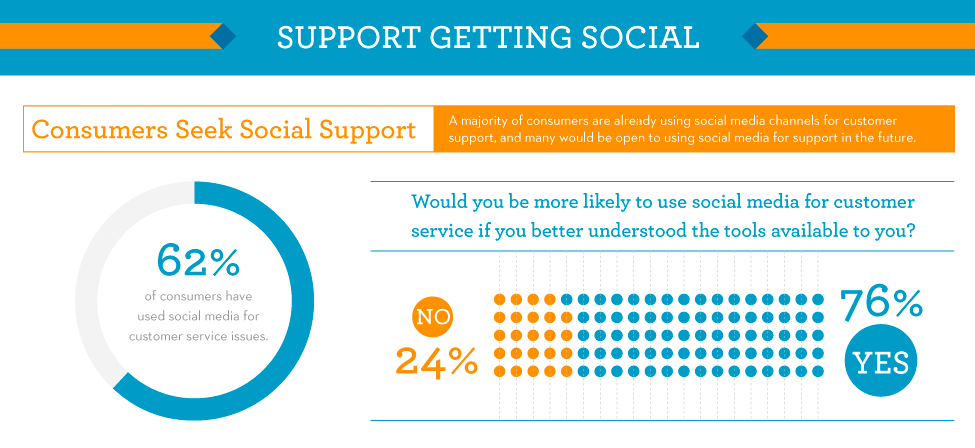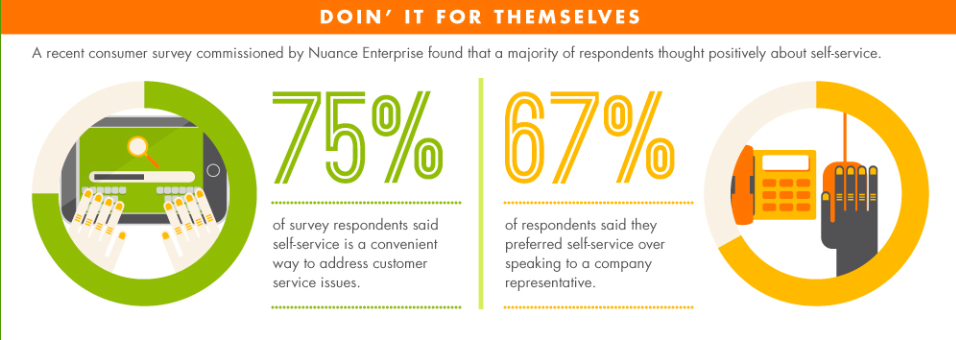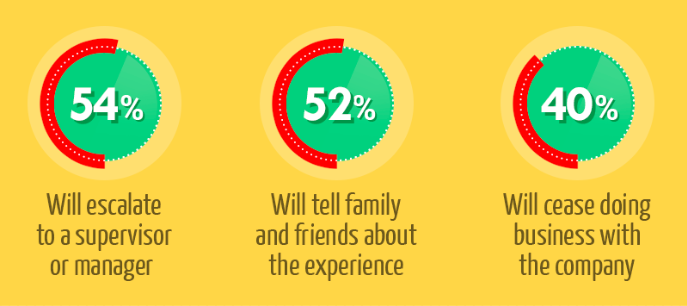Stay updated!
The best customer experience content delivered right to your inbox.
Current and Future Trends in Customer Support in 2019
by UJET Team |
There’s no denying that excellent customer service is crucial for your business.
According to a Harris Interactive poll, 86% of consumers report that they’ve quit doing business with a company because of a poor customer experience. To pour salt in that wound, 89 percent say that they started doing business with a competitor following that disappointing service interaction.
If you want to attract new customers while also keeping your current ones around, then quality customer service is paramount. But with new technologies entering the market and the industry constantly evolving, it can be challenging to keep up.
We’re revisiting a few of our predictions from 2018 and sharing new customer service trends for 2019 you should pay attention to—so you can stay ahead of the curve and focus on providing a top-notch experience for your customers.
1. Customers still expect a consistent support experience
From email and social media to phone calls and live chat, you have plenty of different methods for assisting your customers. There’s nothing more frustrating for a customer than being bounced around from channel to channel and needing to explain their problem four separate times.
As technologies continue to advance, so do customers’ expectations for service.

Reasons to improve the customer experience via SuperOffice.
They expect to be able to access the appropriate channel based on the urgency and complexity of their problem and anticipate that companies have a way to record their information. You need to provide a cohesive and seamless experience across every channel.
What does this mean for you?
You might be surprised. 87% of customers think that companies need to put more work into providing a consistent experience. Using software like UJET makes it easy for your customers to move between support channels and provides the streamlined experience your customers require.
2. Customers will continue to rely on their smartphones
There’s no denying it, mobile is taking over the customer service industry. It all comes back to the convenience that today’s consumers demand. In fact, 70% of customers report using their phones when they need help from a customer service department.
-6.png)
This doesn’t just mean that you need a responsive website or even a dedicated app, but that you need to be thinking of other clever ways to incorporate mobile technology into your support interactions.
What does this mean for you?
That might sound overwhelming, but it doesn’t need to be. UJET allows you to use mobile device hardware like the camera to take photos and record video to help customers and agents understand problems and reach resolutions faster.
3. Live chat will become even more important
The importance of live chat has been at the center of conversations about customer service and experience for years now. And, it’s not going anywhere—in fact, it’s only picking up steam.
Live chat is expected to grow by as much as 87% in the next 12-18 months, and it’s become a standard expectation for consumers. Today, more than 30% of customers expect to see a live chat feature on your website.
-5.png)
Live chat preference via Upscope.
Live chat provides many benefits for customers. It’s convenient, they don’t have to wait on hold, and they can even multitask while they’re getting their questions answered. Put simply, it’s a support channel that requires very little interruption, so it comes as little surprise that it’s continuing to gain popularity.
What does this mean for you?
If live chat isn’t something you already offer for your customers, that’s a trend you should plan to implement this year. UJET’s cloud contact center platform offers chat support to your customers on any device.
4. Social media will continue to be an important support channel
Customers prioritize convenience. They shouldn’t have to go out of their way to get questions answered or problems solved.
That’s why we’ll see more customer service interactions happening on social networks. In fact, one in three social media users prefers social media customer care services to telephone or email.

Social media support stats via Zendesk.
Being responsive on social media presents an opportunity for you as well. Considering that an estimated 30% of all time spent online is allocated to social media, being active on those platforms gives you the chance to meet your customers where they already are.
What does this mean for you?
Customers anticipate that you’ll be available on these platforms, and failing to respond can lead to a 15% increase in churn rate for existing customers. So, if you don’t already have one, form a plan for how you’ll handle customer inquiries on social media. It can’t be looked at as an afterthought or a less important part of your customer experience.
5. Companies will find new ways to leverage customer data
You have more information about your customers than ever before. But those insights don’t do any good if you never do anything with them.
That’s exactly why we’ll see a growing emphasis on customer data, and ways to leverage that information to provide superior experiences.
-3.png)
When nearly 70% of consumers want a personalized experience, things like user segmentation and predictive analytics will help companies proactively develop strategies to support and delight their customers.
What does this mean for you?
You need a convenient, organized and secure way to store your data and leverage it appropriately in your customer interactions.
UJET uses customer data for smarter customer routing and to also give your support agents the important information they need upfront—so that they can focus on resolving the issue and delivering better solutions.
6. Customers still want to get in touch with you directly
You’ve heard all of the chatter about how artificial intelligence (AI) is taking over the world—especially customer interactions.
AI is helpful when it comes to providing efficient solutions for smaller issues, such as updating an email address or tracking the status of an order.
-2.png)
However, when it comes to more complex problems or questions, customers still want to get in touch with a real, live person on your support team—and they want to do it fast. A whopping 75 %of consumers say that it takes too long to reach a live agent for support.
What does this mean for you?
This doesn’t mean that you can’t leverage AI or other technologies to remove some bloat from your processes. You just need to make sure that people can reach a live customer support specialist in two minutes or less. Anything longer than that will only add frustration.
It’s also smart to walkthrough your own customer support process regularly, so you can spot any bottlenecks or potential frustrations from the customer’s perspective.
7. There will be greater focus on using AI the right way
We’ve already mentioned AI, and there’s no denying that it will continue to be a topic of conversation in every industry—including customer service.
There’s also growing emphasis on using it the right way. Particularly when customers still appreciate a connection with a real person, AI shouldn’t entirely replace human contact in customer support. It’s not a way to unload the burden of your customers, but instead to find ways to better serve them.

Chatbot stats via Digitalgo.
As we look to a future where an estimated 85% of customer conversations will be handled using AI, it’s important to consider how you’ll use this technology to your customers’ advantage—without losing the human touch they still crave.
What does this mean for you?
Nobody’s denying that AI is great for making customer support processes more efficient. But, make sure that you’re carefully evaluating how those efforts will be perceived by your customers.
For example, AI is a fitting choice for funneling your customers to the right places or support channels. But, using a bot to handle complex interactions or problems, on the other hand, likely won’t generate respect and appreciation from your customers.
8. It’s all about the customer journey
The term “omnichannel” is something you hear a lot in the industry. It’s a great way to talk about how your customers interact with the company at every point along the customer journey.
Previously, these separate support channels were managed in isolation, which made moving between them clunky and complicated.
-2.png)
The Customer Journey
But, today, companies are challenged to think less about support channels as standalone entities, and more about the overarching strategy of how customers journey through them.
What does this mean for you?
We’ve already mentioned the importance of providing a consistent experience for your customers, which means you need to map out your customer journey to provide a seamless transition between your various support channels.
UJET can help you elevate your customer support by making it easy for both your customers and your support team to move throughout those different channels.
9. Customers want to be able to find answers on their own
As great as your customer support agents are, sometimes your customers don’t want to interact with them at all. They’d rather easily find the information they need on their own.
67% of customers prefer having self-service customer service options available on a website. It’s simpler and less time consuming for them to seek out the answers themselves.

Self service stats via Zendesk.
When 73 % of customers say that valuing their time is the most important thing a company can do to provide them with excellent customer service, having these independent options available is a surefire way to boost customer happiness.
What does this mean for you?
If you don’t already have one, it’s time to build out a robust knowledge base or easily accessible support documentation for your customers.
Not only does this give them the information that they want, but it also can reduce the number of inquiries that actually get to your customer support team—as customers are able to answer their own questions themselves.
10. Customer service will be an important part of marketing strategy
From influencer marketing to targeted advertisements, there’s no shortage of clever ways that companies try to wiggle into the hearts and minds of consumers.
But, regardless of what shiny new strategies crop up, it still all comes back to customer experience.

Negative customer service stats via Provide Support.
According to Nielsen, 92% of people trust recommendations from friends and family over any other type of advertising. 74% of consumers identify word of mouth as a key influencer in their purchasing decisions. And, 58% of consumers are more likely to tell others about their customer service experiences than they were five years ago.
What does this mean for you?
Put simply, using the above trends and tips to provide a solid customer experience is of paramount importance. All of the marketing efforts in the world won’t help if that foundation isn’t in place.
Prioritize the customer experience in customer service
You’ll notice that there’s a common thread between the vast majority of the trends we outlined here—they all come back to making things easier and more convenient for your customer.
That isn’t a happy accident. Ultimately, customer service needs to live up to its name and serve the customer. Make that your priority, and the rest will start to fall into place.
The best customer experience content delivered right to your inbox.